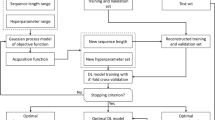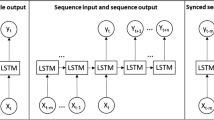Abstract
Water coning is one of the common issues in subsurface systems in which water flows into the production well through perforated zones. This phenomenon can cause severe problems in wellbore and surface facilities. Thus, accurate prediction of water breakthrough can help to adapt to the production mode and avoid such issues. Conducting flow simulations, as a conventional approach, can be very time demanding if one deals with large subsurface systems. Furthermore, several types of data are often collected during the life of a subsurface system each of which can help to predict the breakthrough and water coning. As such, it is very important to produce similar results using the time sequence data gathered from various geo-sensing tools. In this paper, a deep long short-term memory (LSTM) model is developed to predict the water cut and water breakthrough time for multiple production wells in a water flooding case. The dataset is generated by the Egg model with a multi-input-multi-output system. We found that the proposed model can capture the general trend of variation for the water cut time sequence data for a complex subsurface system. To evaluate the performance of our data-driven method, the results are compared with vanilla recurrent neural network (RNN), deep gated recurrent unit (GRU), and artificial neural network (ANN). The conducted comparison indicates that the proposed deep LSTM model outperforms the other three approaches when the results are compared with the numerical data.
Similar content being viewed by others
References
Ahmed, T.H.: Reservoir engineering handbook. Gulf Pub. Co. (2000)
Hoyland, L.A., Papatzacos, P., Skjaeveland, S.M.: Critical rate for water coning. Correlation and analytical solution. SPE Reserv. Eng. Society Pet. Eng. 4, 495–502 15855 (1989). https://doi.org/10.2118/15855-pa
Wagenhofer, T., Hatzignatiou, D.G.: Optimization of horizontal well placement. In: SPE Western Regional Meeting. Society of Petroleum Engineers (1996)
Muskat, M., Wycokoff, R.D.: An approximate theory of water-coning in oil production. Trans. AIME. 114, 144–163 (1935). https://doi.org/10.2118/935144-g
Chaney, P.E., Noble, M.D., Henson, W.L., Rice, T.D.: How to perforate your well to prevent water and gas coning. Oil Gas J. 55, 108–114 (1956)
Chierici, G.L., Ciucci, G.M., Pizzi, G.: A systematic study of gas and water coning by potentiometric models. J. Pet. Technol. 16, 923–929 (1964). https://doi.org/10.2118/871-pa
Wheatley, M.J.: An approximate theory of oil/water coning. In: SPE Annual Technical Conference and Exhibition. Society of Petroleum Engineers (1985)
Abass, H.H., Bass, D.M.: The critical production rate in water-coning system. In: Permian Basin Oil and Gas Recovery Conference. Society of Petroleum Engineers (1988)
Guo, B., Lee, R.L.H.: Simple approach to optimization of completion interval in oil/water coning systems. SPE Reserv. Eng. Society Pet. Eng. 8, 249–255 (1993). https://doi.org/10.2118/23994-pa
Schols, R.S.: An empirical formula for the critical oil production rate. Erdoel Erdgas. 88, 6–11 (1972)
Zendehboudi, S., Elkamel, A., Chatzis, I., Ahmadi, M.A., Bahadori, A., Lohi, A.: Estimation of breakthrough time for water coning in fractured systems: experimental study and connectionist modeling. AICHE J. 60, 1905–1919 (2014). https://doi.org/10.1002/aic.14365
Ozkan, E., Raghavan, R.: Performance of horizontal wells subject to bottomwater drive. SPE Reserv. Eng. Society Pet. Eng. 5, 375–383 (1990). https://doi.org/10.2118/18559-PA
Yang, W., Wattenbarger, R.A.: Water coning calculations for vertical and horizontal wells. In: SPE Annual Technical Conference and Exhibition. Society of Petroleum Engineers (1991)
Papatzacos, P., Herring, T.R., Martinsen, R., Skjaeveland, S.M.: Cone breakthrough time for horizontal wells. SPE Reserv. Eng. Society Pet. Eng. 6, 311–318 (1991). https://doi.org/10.2118/19822-PA
Omeke, J.E., Livinus, A., Uche, I.N., Obah, B., Ekeoma, E.: A proposed cone breakthrough time model for horizontal wells in thin oil rim reservoirs. In: Society of Petroleum Engineers - Nigeria Annual International Conference and Exhibition 2010, NAICE, pp. 963–973 (2010)
Ahmadi, M.A., Ebadi, M., Hosseini, S.M.: Prediction breakthrough time of water coning in the fractured reservoirs by implementing low parameter support vector machine approach. Fuel. 117, 579–589 (2014). https://doi.org/10.1016/j.fuel.2013.09.071
Bai, T., Tahmasebi, P.: Hybrid geological modeling: combining machine learning and multiple-point statistics. Comput. Geosci. 104519 (2020). https://doi.org/10.1016/j.cageo.2020.104519
Kamrava, S., Tahmasebi, P., Sahimi, M.: Enhancing images of shale formations by a hybrid stochastic and deep learning algorithm. Neural Netw. 118, 310–320 (2019). https://doi.org/10.1016/J.NEUNET.2019.07.009
Kamrava, S., Tahmasebi, P., Sahimi, M.: Linking morphology of porous media to their macroscopic permeability by deep learning. Transp. Porous Media. 131, 427–448 (2019). https://doi.org/10.1007/s11242-019-01352-5
Kamrava, S., Sahimi, M., Tahmasebi, P.: Quantifying accuracy of stochastic methods of reconstructing complex materials by deep learning. Phys. Rev. E. 101, 043301 (2020). https://doi.org/10.1103/PhysRevE.101.043301
Tahmasebi, P., Sahimi, M., Shirangi, M.G.: Rapid learning-based and geologically consistent history matching. Transp. Porous Media. 122, 279–304 (2018). https://doi.org/10.1007/s11242-018-1005-6
Tahmasebi, P., Kamrava, S., Bai, T., Sahimi, M.: Machine learning in geo- and environmental sciences: from small to large scale. Adv. Water Resour. 142, 103619 (2020). https://doi.org/10.1016/j.advwatres.2020.103619
Werbos, P.J.: Backpropagation through time: what it does and how to do it. Proc. IEEE. 78, 1550–1560 (1990). https://doi.org/10.1109/5.58337
Bengio, Y., Simard, P., Frasconi, P.: Learning long-term dependencies with gradient descent is difficult. IEEE Trans. Neural Netw. 5, 157–166 (1994). https://doi.org/10.1109/72.279181
Hochreiter, S., Schmidhuber, J.: Long short-term memory. Neural Comput. 9, 1735–1780 (1997). https://doi.org/10.1162/neco.1997.9.8.1735
Nelson, D.M.Q., Pereira, A.C.M., De Oliveira, R.A.: Stock market’s price movement prediction with LSTM neural networks. In: Proceedings of the International Joint Conference on Neural Networks. pp. 1419–1426. Institute of Electrical and Electronics Engineers Inc. (2017)
Zhang, Q., Wang, H., Dong, J., Zhong, G., Sun, X.: Prediction of sea surface temperature using long short-term memory. IEEE Geosci. Remote Sens. Lett. 14, 1745–1749 (2017). https://doi.org/10.1109/LGRS.2017.2733548
Zhao, J., Deng, F., Cai, Y., Chen, J.: Long short-term memory - fully connected (LSTM-FC) neural network for PM2.5 concentration prediction. Chemosphere. 220, 486–492 (2019). https://doi.org/10.1016/j.chemosphere.2018.12.128
Du, B., Peng, H., Wang, S., Bhuiyan, M.Z.A., Wang, L., Gong, Q., Liu, L., Li, J.: Deep irregular convolutional residual LSTM for urban traffic passenger flows prediction. IEEE Trans. Intell. Transp. Syst, pp. 1–14 (2019). https://doi.org/10.1109/tits.2019.2900481
Kamrava, S., Tahmasebi, P., Sahimi, M., Arbabi, S.: Phase transitions, percolation, fracture of materials, and deep learning. Phys. Rev. E. 102, 011001 (2020). https://doi.org/10.1103/PhysRevE.102.011001
Jansen, J.D., Fonseca, R.M., Kahrobaei, S., Siraj, M.M., Van Essen, G.M., Van den Hof, P.M.J.: The egg model - a geological ensemble for reservoir simulation. Geosci. Data J. 1, 192–195 (2014). https://doi.org/10.1002/gdj3.21
Nasrabadi, N.M., Choo, C.Y.: Hopfield network for stereo vision correspondence. IEEE Trans. Neural Netw. 3, 5–13 (1992). https://doi.org/10.1109/72.105413
Pascanu, R., Mikolov, T., Bengio, Y.: On the difficulty of training recurrent neural networks. (2012)
Gers, F.: Long short-term memory in recurrent neural networks, (2001)
Tahmasebi, P., Kamrava, S.: A multiscale approach for geologically and flow consistent modeling. Transp. Porous Media. 124, 237–261 (2018). https://doi.org/10.1007/s11242-018-1062-x
Tahmasebi, P.: Multiple point statistics: a review. In: Handbook of Mathematical Geosciences, pp. 613–643. Springer International publishing, Cham (2018)
Alumbaugh, D.L., Morrison, H.F.: Theoretical and practical considerations for crosswell electromagnetic tomography assuming a cylindrical geometry. Geophysics. 60, 846–870 (1995). https://doi.org/10.1190/1.1443822
Wilt, M.J., Alumbaugh, D.L., Morrison, H.F., Becker, A., Lee, K.H., Deszcz-Pan, M.: Crosswell electromagnetic tomography: system design considerations and field results. Geophysics. 60, 871–885 (1995). https://doi.org/10.1190/1.1443823
Constable, S., Cox, C.S.: Marine controlled-source electromagnetic sounding: 2 the PEGASUS experiment. J. Geophys. Res. Solid Earth. 101, 5519–5530 (1996). https://doi.org/10.1029/95jb03738
MacGregor, L., Sinha, M., Constable, S.: Electrical resistivity structure of the Valu Fa Ridge, Lau Basin, from marine controlled-source electromagnetic sounding. Geophys. J. Int. 146, 217–236 (2001). https://doi.org/10.1046/j.1365-246X.2001.00440.x
Archie, G.E.: The electrical resistivity log as an aid in determining some reservoir characteristics. Pet. Trans. AIME. 146, 54–62 (1942). https://doi.org/10.2118/942054-G
Raghu, M., Poole, B., Kleinberg, J., Ganguli, S., Dickstein, J.S.: On the expressive power of deep neural networks. In: Proceedings of the 34th International Conference on Machine Learning - Volume 70. pp. 2847–2854. JMLR.org (2017)
Eldan, R., Shamir, O.: The power of depth for feedforward neural networks. In: Journal of Machine Learning Research. pp. 907–940. Microtome Publishing (2016)
Hermans, M., Schrauwen, B.: Training and analysing deep recurrent neural networks. In: Burges, C.J.C., Bottou, L., Welling, M., Ghahramani, Z., and Weinberger, K.Q. (eds.) Advances in neural information processing systems 26. pp. 190–198. Curran Associates, Inc. (2013)
Langkvist, M., Karlsson, L., Loutfi, A.: A review of unsupervised feature learning and deep learning for time-series modeling. Pattern Recogn. Lett. 42, 11–24 (2014). https://doi.org/10.1016/j.patrec.2014.01.008
Spiegel, S., Gaebler, J., Lommatzsch, A., De Luca, E., Albayrak, S.: Pattern recognition and classification for multivariate time series. In: Proceedings of the Fifth International Workshop on Knowledge Discovery from Sensor Data, pp. 34–42. Association for Computing Machinery, New York (2011)
Chung, J., Gulcehre, C., Cho, K., Bengio, Y.: Empirical evaluation of gated recurrent neural networks on sequence modeling. (2014)
Chollet, F., others: Keras (2015), (2017)
Srivastava, N., Hinton, G., Krizhevsky, A., Sutskever, I., Salakhutdinov, R.: Dropout: a simple way to prevent neural networks from overfitting. J. Mach. Learn. Res. 15, 1929–1958 (2014)
Acknowledgments
The comments from two anonymous referees are also acknowledged.
Funding
This work was financially supported by the School of Energy Resources and the University of Wyoming.
Author information
Authors and Affiliations
Corresponding author
Additional information
Publisher’s note
Springer Nature remains neutral with regard to jurisdictional claims in published maps and institutional affiliations.
Rights and permissions
About this article
Cite this article
Bai, T., Tahmasebi, P. Efficient and data-driven prediction of water breakthrough in subsurface systems using deep long short-term memory machine learning. Comput Geosci 25, 285–297 (2021). https://doi.org/10.1007/s10596-020-10005-2
Received:
Accepted:
Published:
Issue Date:
DOI: https://doi.org/10.1007/s10596-020-10005-2




